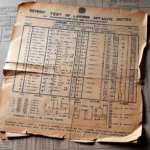The Detroit Tests of Learning Aptitude, often abbreviated as DTLA, is a comprehensive battery of tests designed to measure a child’s learning and cognitive abilities. It has become an essential tool in the field of educational psychology and has been widely utilized by professionals to evaluate students’ strengths and weaknesses in various areas of intellectual functioning. Assessing a child’s learning aptitude can be critical in designing appropriate educational interventions and supporting their academic success. This article aims to provide an overview of the DTLA, discussing its history, purpose, components, and importance in the educational landscape.
First developed in 1948 by psychologist Harry A. Dahlstrom, the DTLA has undergone numerous revisions and updates to ensure its relevance and effectiveness in assessing learning aptitude. The most current version, the DTLA-5, is designed for use with children and adolescents ranging from ages 6 years old to 17 years 11 months. The tests are standardized, meaning they have been administered to a large, representative sample of children to establish norms that are used for comparison.
The DTLA is commonly used by psychologists, educators, and speech-language pathologists to identify learning disabilities, developmental delays, and intellectual disabilities. It can also be instrumental in the diagnosis of attention-deficit/hyperactivity disorder (ADHD) and autism spectrum disorder (ASD). By identifying specific areas of difficulty, the DTLA aids in creating targeted strategies to help each student achieve their fullest potential. The results of the DTLA can guide educational planning, including special education services, and inform necessary therapy or interventions.
The test is composed of a series of subtests that measure various cognitive functions such as attention, memory, auditory and visual processing, conceptual and verbal abilities, and problem-solving skills. These subtests evaluate both verbal and nonverbal aspects of intelligence and learning, which is particularly beneficial since some children may have disparities in their ability profiles.
The DTLA subtests include assessments of word definition and usage, design reproduction, sentence imitation, and verbal absurdities, among others. Each one is carefully constructed to measure specific cognitive domains:
1. Word Definitions: This subtest evaluates a child’s vocabulary and ability to provide distinct definitions for words.
2. Design Reproduction: This visual-spatial task requires a child to view a complex figure and then recreate it from memory, assessing visual memory and spatial organization.
3. Sentence Imitation: Children are asked to repeat sentences of increasing complexity, testing auditory memory and linguistic processing.
4. Verbal Absurdities: This subtest measures a child’s ability to identify and explain the absurdity in a given statement, tapping into critical thinking and reasoning skills.
These are just a handful of the numerous evaluations DTLA encompasses, all of which contribute to an intricate understanding of a child’s cognitive capabilities and areas of need.
The scoring system of the DTLA is designed to provide detailed information, both qualitative and quantitative. Scores are generated for each subtest, which include standard scores, percentile ranks, and age equivalents. The overall composite score reflects a child’s general intellectual ability. Clinicians and educators are careful to consider the child’s educational background, cultural context, and language proficiency when interpreting the results, as these factors can significantly influence test performance.
The importance of the DTLA in educational and psychological assessments lies in its ability to provide an in-depth look at a child’s learning aptitude. Unlike other tests that may focus solely on academic achievement, the DTLA digs deeper into the cognitive processes underlying learning. This comprehensive approach is what sets the DTLA apart and makes it a valued tool in the field of psychology and education.
One of the critical roles of the DTLA is in the early identification of learning disabilities. Early detection of issues such as dyslexia, dyscalculia, or other specific learning disorders can lead to early intervention, which is often key to helping children overcome or manage their challenges. For students already struggling in school, DTLA results can validate their experiences, leading to better understanding and support from teachers, parents, and peers.
For children with suspected developmental delays or intellectual disabilities, the DTLA can serve not only as a diagnostic tool but as a guide for what kind of support or resources might be most beneficial. It helps in setting realistic expectations and in tailoring educational experiences that are both challenging and achievable for the student.
In the case of attentional disorders like ADHD, the DTLA subtests that focus on attention and concentration can assist in distinguishing between a primary attentional problem and difficulties that may stem from other cognitive issues such as working memory deficits or slow processing speed. This distinction is crucial for developing effective treatment plans and accommodation strategies.
For children with ASD, the DTLA can provide insights into the uneven cognitive profiles that are often characteristic of autism. By understanding their unique strengths and deficits, educators and parents can construct learning environments that promote growth while respecting the child’s individual learning style.
The adaptability of the DTLA also makes it a useful tool for reevaluation. As children grow and develop, their cognitive abilities can change. Regular retesting with the DTLA can monitor progress and adjust educational plans accordingly. It ensures that interventions remain relevant to the child’s current needs and facilitates a lifelong approach to learning support.
In conclusion, the Detroit Tests of Learning Aptitude represent a crucial resource in the assessment of children’s cognitive abilities. Providing valuable insights into a child’s learning strengths and challenges, DTLA results can inform targeted educational strategies. Whether used for diagnosing learning disabilities, evaluating intellectual capabilities, or guiding educational planning, the DTLA is a multifaceted tool that supports the individualized approach that is vital for the educational success and overall well-being of children and adolescents. Its continued use in psychological and educational settings underscores the enduring importance of comprehensive, nuanced assessments in shaping the future of education and learning support.

